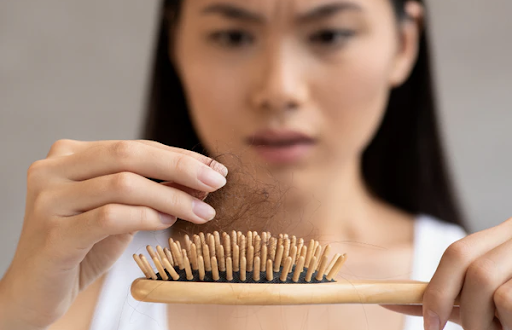Among the various treatments available, minoxidil has emerged as a popular choice for many seeking to combat hair thinning and regrowth. This article explores the benefits, potential drawbacks, and key considerations to help you make an informed decision.
What Is Minoxidil?
Minoxidil is a topical treatment that is primarily used to stimulate hair regrowth in individuals experiencing androgenetic alopecia, commonly known as male or female pattern baldness. Originally developed as an oral medication for hypertension, it was found to have a surprising side effect: increased hair growth. Today, it is available over-the-counter in liquid or foam formulations, typically in 2% and 5% concentrations.
How Minoxidil Works?
Minoxidil operates through several mechanisms:
- Vasodilation: It widens blood vessels, increasing blood flow to hair follicles. This improved circulation nourishes the follicles, promoting healthy growth.
- Prolonging the Anagen Phase: Minoxidil helps extend the anagen (growth) phase of the hair cycle, allowing hair to grow for a more extended period.
- Follicle Stimulation: Minoxidil stimulates cellular activity in the hair follicles and encourages the transition from the telogen (resting) phase to the anagen phase, leading to new hair growth.
- Counteracting Androgens: In cases of androgenetic alopecia, minoxidil may help counteract the effects of androgens, which can shrink hair follicles and shorten the growth phase.
Who Can Benefit from Minoxidil?
Minoxidil is suitable for many individuals, but specific factors can influence its effectiveness:
- Type of Hair Loss
Minoxidil is most effective for androgenetic alopecia, whether in men or women. If your hair loss stems from other causes, such as alopecia areata or scarring, you should explore different treatments.
- Duration of Hair Loss
Individuals who have recently experienced hair loss generally respond better to minoxidil than those who have been balding for an extended period. The sooner you start treatment after noticing thinning, the better your chances of success.
- Age
Younger individuals tend to have more resilient hair follicles, which can lead to more positive outcomes with minoxidil. Older adults may experience a slower response, but some still find it beneficial.
- Overall Health
Your general health can impact hair regrowth. Conditions such as hormonal imbalances, nutritional deficiencies, or significant stress can hinder results. Addressing these underlying issues is essential for the best outcomes.
Benefits of Using Minoxidil
Over-the-Counter Availability
Minoxidil is readily available without a prescription, making it easily accessible for those seeking to address hair loss.
Proven Effectiveness
Many users report visible results within four to six months of consistent application.
Non-Invasive Treatment
Unlike surgical options such as hair transplants, minoxidil offers a non-invasive solution for hair regrowth, appealing to those who prefer to avoid surgical procedures.
Easy to Use
Minoxidil is straightforward to apply, with clear instructions provided. Most users find it easy to incorporate into their daily routines.
Potential Drawbacks of Minoxidil
Consistency Required
Minoxidil requires consistent application—typically twice daily—to maintain results. If treatment is stopped, any new hair growth may be lost, and the user may revert to their previous level of hair loss.
Time for Results
It can take several months to see noticeable results, which may be frustrating for some users.
Side Effects
While generally safe, minoxidil can cause side effects such as scalp irritation, itching, and, in some cases, unwanted facial hair growth. Users should monitor their reactions and consult a healthcare professional if side effects persist.
Limited Effectiveness
Minoxidil may not work for everyone. Factors such as the extent of hair loss, genetic predisposition, and individual response can affect treatment outcomes.
Is Minoxidil the Best Option for You?
Deciding whether minoxidil is the best Australian treatment for hair loss involves several considerations:
Consultation with a Healthcare Provider
Before starting any treatment, it’s wise to consult a healthcare provider or dermatologist. They can help determine the cause of your hair loss and whether minoxidil is appropriate for your situation.
Evaluate Your Commitment
Assess your willingness to commit to a daily routine and the patience required to see results. Minoxidil may not be ideal if you’re looking for a quick fix.
Consider Alternative Treatments
Explore other options, such as finasteride (for men), low-level laser therapy, or natural remedies. Some individuals find success with a combination of treatments.
Lifestyle Factors
Consider your overall health and lifestyle. Factors such as stress management, nutrition, and exercise can impact hair health, and addressing these can complement any treatment regimen.
Conclusion
Minoxidil is a well-researched and widely used treatment for hair loss, offering a non-invasive option for many individuals. Its ability to promote hair regrowth through improved circulation and follicle stimulation makes it an appealing choice. However, it’s crucial to weigh the potential benefits against the drawbacks and consult with a healthcare provider to determine the best approach for your unique situation.
Ultimately, with the right commitment and understanding, minoxidil can be a valuable tool in restoring hair and confidence.
 Crypto trade Online Unlock the Future of Finance Today.
Crypto trade Online Unlock the Future of Finance Today.




